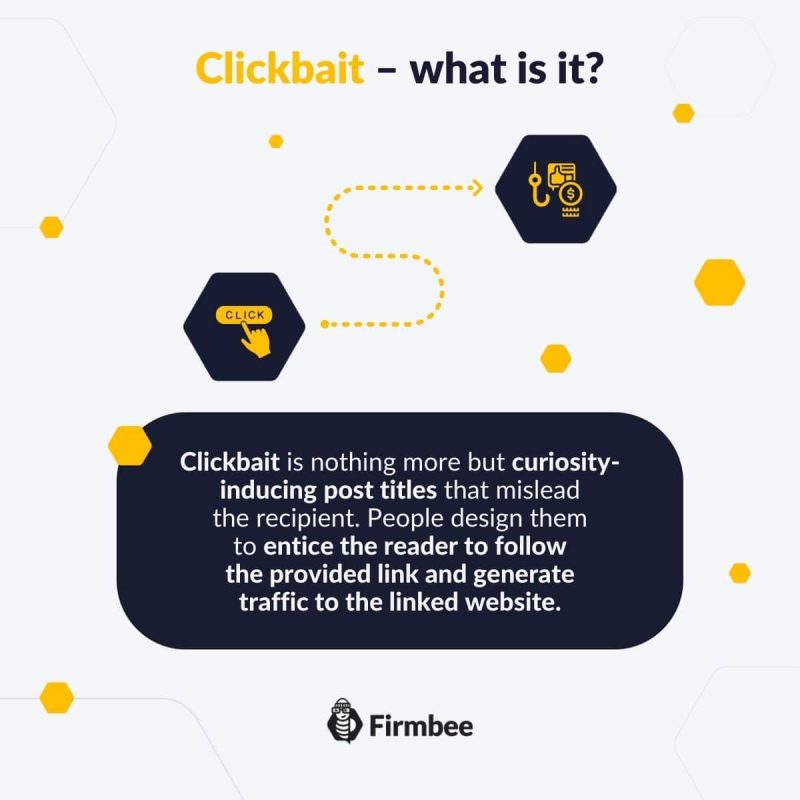Clickbait in article titles is one way to attract a large number of readers. But is it worth using this method on a blog?
This isn’t going to be another article in the “TRUSTED WAY TO SUCCEED IN MARKETING” or “DO THIS AND YOU’LL BE GOD” series. If that were the case, no doubt the title of this content could be called clickbait.
Clickbait in headlines – table of contents:
- Clickbait – what is it and when can we talk about it?
- Clickbait – usage examples and post titles
- Is it worth using clickbait?
- How do you write post titles to generate attention?
The lure of a catchy but not truthful headline can generate a lot of traffic. However, it has one major drawback – it irrevocably destroys the trust of the attracted audience. Is it worth risking for a quick but fleeting increase in temporary visits?
Clickbait – what is it and when can we talk about it?
The global ubiquity of the Internet results in wide access to information at any time, for any person with access to the network. With the transfer of knowledge to the Internet, it has become a kind of guide-base, a place to broaden horizons, a virtual library. People have learned to search for information using simple, intuitive phrases typed into the search engine. Too long content becomes unattractive for a user looking for express information. Companies, authors and publicists use this fact and intentionally confuse the recipient with “click bait”.
Clickbait is nothing more but curiosity-inducing post titles that mislead the recipient. People design them to entice the reader to follow the provided link and generate traffic to the linked website. Catchy yet fake headlines are used everywhere – on blogs, on websites, in video titles. They have become a common tool to quickly increase the number of visitors.
Clickbait – usage examples and post titles
Researchers from the Oxford English Dictionary define clickbait as content that is designed to grab the attention of the viewer. This is certainly a very general and imprecise definition that does not fully explain clickbait. The full meaning of the English expression has a slightly more pejorative character. It refers to the marketing phenomenon of “curiosity gap”.
Curiosity gap is about triggering an audience to expand their knowledge after reading a catchy topic. However, in the case of clickbait articles, this need is not met. A disappointed viewer, who realizes that he or she will not receive the desired information, reacts with disappointment. As a result occur irritation and a decrease in interest.

Examples of “bait” headlines might include the following article titles:
- The secret of Lewandowski’s success. Famous footballer revealed the secret
- Tragedy and disbelief. It can happen to anyone
- People are starting to die in large numbers. How to avoid death?
A text editor intentionally introduces shocking phrases in order to arouse the user’s interest. Hyperbolizing the seriousness of the situation with exaggerated phrases is used in order to increase the number of views, increase the profit from advertising, gain publicity in the network.
Is it worth using clickbait?
The immediate effects of using false headlines disappear in the mist of the many drawbacks that go behind this kind of “baiting” of the viewer. The use of clickbait misses the basic principle of marketing relations – building a connection with your audience by providing them with what they need in the moment. It is also antagonistic to the proven processes found in advertising.
Psychological conditioning of recipients has been presented, among others, in the AIDA model, which assumes four consecutive stages of recipient response. Clickbait does draw attention, arouse interest, and may even evoke desire, but at the action stage, the recipient is confronted with an insurmountable obstacle. It is false information that does not fit into the context of the headline or lack of promised information, which effectively disappoints the visitor.
How do you write post titles to generate attention?
Most importantly, a well-written headline must be an intuitive blueprint, a summary of the article, not a fabricated and unsupportable cluster of words. Blog post titles need to be written in light, but contextually appropriate language. Using clickbait is like walking on thin ice. We don’t know at what point a user will irrevocably abandon an article that doesn’t give them the satisfaction of filling the “curiosity gap”. If you want to learn more how to write catchy headlines, check some tips we prepared.
Author: Mira Bodhi
Knows all the pros and cons of working as a Freelancer and still makes the best of it. Time management and self-motivation are her biggest advantages. She is now a digital nomad and works traveling all over the world.


















